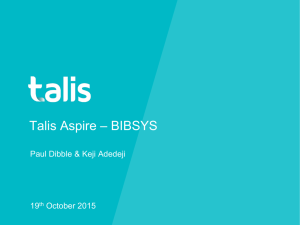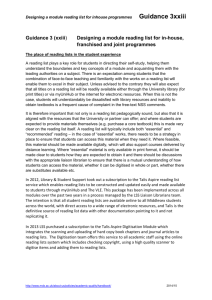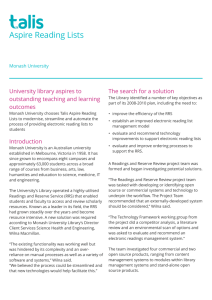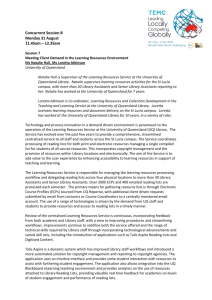UNITED STATES OF AMERICA
advertisement
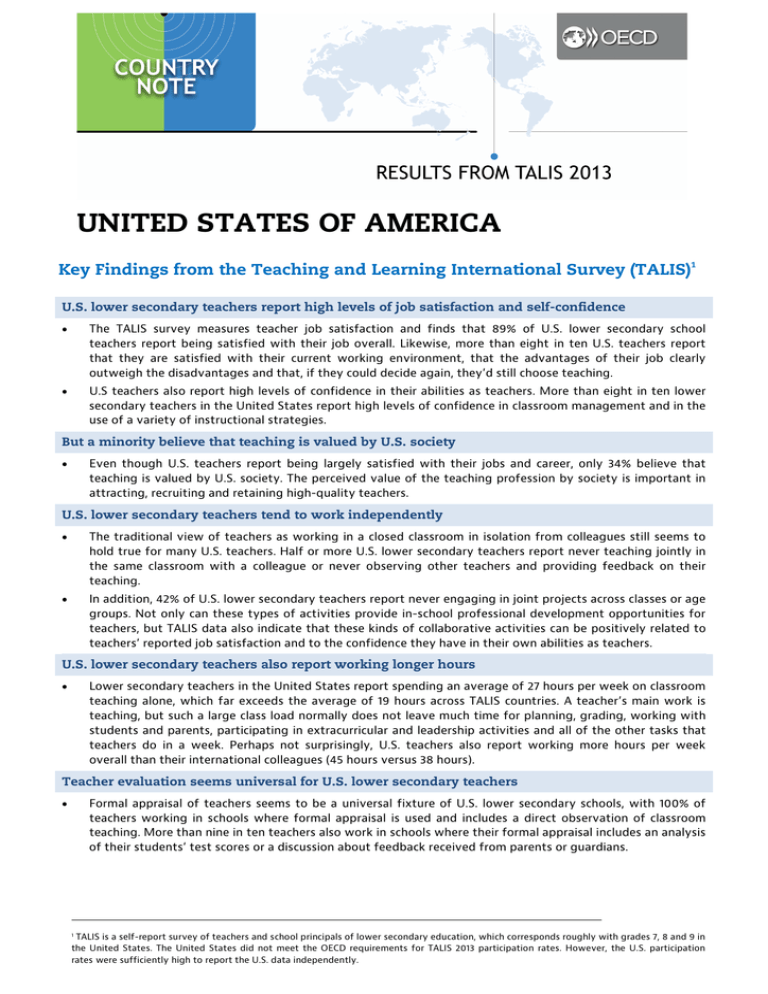
UNITED STATES OF AMERICA Key Findings from the Teaching and Learning International Survey (TALIS)1 U.S. lower secondary teachers report high levels of job satisfaction and self-confidence • The TALIS survey measures teacher job satisfaction and finds that 89% of U.S. lower secondary school teachers report being satisfied with their job overall. Likewise, more than eight in ten U.S. teachers report that they are satisfied with their current working environment, that the advantages of their job clearly outweigh the disadvantages and that, if they could decide again, they’d still choose teaching. • U.S teachers also report high levels of confidence in their abilities as teachers. More than eight in ten lower secondary teachers in the United States report high levels of confidence in classroom management and in the use of a variety of instructional strategies. But a minority believe that teaching is valued by U.S. society Even though U.S. teachers report being largely satisfied with their jobs and career, only 34% believe that teaching is valued by U.S. society. The perceived value of the teaching profession by society is important in attracting, recruiting and retaining high-quality teachers. • U.S. lower secondary teachers tend to work independently • The traditional view of teachers as working in a closed classroom in isolation from colleagues still seems to hold true for many U.S. teachers. Half or more U.S. lower secondary teachers report never teaching jointly in the same classroom with a colleague or never observing other teachers and providing feedback on their teaching. • In addition, 42% of U.S. lower secondary teachers report never engaging in joint projects across classes or age groups. Not only can these types of activities provide in-school professional development opportunities for teachers, but TALIS data also indicate that these kinds of collaborative activities can be positively related to teachers’ reported job satisfaction and to the confidence they have in their own abilities as teachers. U.S. lower secondary teachers also report working longer hours Lower secondary teachers in the United States report spending an average of 27 hours per week on classroom teaching alone, which far exceeds the average of 19 hours across TALIS countries. A teacher’s main work is teaching, but such a large class load normally does not leave much time for planning, grading, working with students and parents, participating in extracurricular and leadership activities and all of the other tasks that teachers do in a week. Perhaps not surprisingly, U.S. teachers also report working more hours per week overall than their international colleagues (45 hours versus 38 hours). • Teacher evaluation seems universal for U.S. lower secondary teachers Formal appraisal of teachers seems to be a universal fixture of U.S. lower secondary schools, with 100% of teachers working in schools where formal appraisal is used and includes a direct observation of classroom teaching. More than nine in ten teachers also work in schools where their formal appraisal includes an analysis of their students’ test scores or a discussion about feedback received from parents or guardians. • TALIS is a self-report survey of teachers and school principals of lower secondary education, which corresponds roughly with grades 7, 8 and 9 in the United States. The United States did not meet the OECD requirements for TALIS 2013 participation rates. However, the U.S. participation rates were sufficiently high to report the U.S. data independently. 1 UNITED STATES OF AMERICA – Country Note –Results from TALIS 2013 The typical lower secondary teacher and principal in the United States The following tables present data on the “average” U.S. teacher and school principal as compared with the average across all TALIS 2013 countries.1 Several points are interesting to note. First, U.S. teachers— as well as their school principals—have high levels of education. Nearly all teachers and 100% of principals report having completed a university or equivalent level of education, and 95% of teachers have completed a teacher education or training programme. While it seems that U.S. teachers teach in larger classes or in schools with larger student-to-teacher ratios, TALIS data also show that, in the U.S., principals report that there is one pedagogical support staff for every eight teachers on average. (The international average is one support staff for every 14 teachers.) In addition, U.S. principals are less likely than principals in other TALIS countries to report that they have teaching obligations. Typical teacher in TALIS countries 68% are women Is 43 years old on average Typical teacher in the United States 64% are women Is 42 years old on average 91% completed university or other equivalent higher education 99% completed university or other equivalent higher education 90% completed a teacher education or training programme 95% completed a teacher education or training programme Has an average of 16 years of teaching experience Has an average of 14 years of teaching experience 82% are employed full time and 83% have a permanent contract 96% are employed full time and 67% have a permanent contract Teaches in a class with 24 students on average Teaches in a class with 27 students on average Typical principal in TALIS countries Typical principal in the United States 51% are men Is 52 years old on average 51% are men Is 48 years old on average 96% completed university or other equivalent higher education 100% completed university or other equivalent higher education 90% completed a teacher education or training programme, 85% a school administration/principal training programme and 78% instructional leadership training 100% completed a teacher education or training programme, 100% a school administration/principal training programme and 100% instructional leadership training Has an average of 9 years of experience as a principal and 21 years of teaching experience Has an average of 7 years of experience as a principal and 13 years of teaching experience 62% are employed full time without teaching obligations and 35% are employed full time with teaching obligations 93% are employed full time without teaching obligations and 4% are employed full time with teaching obligations Works in a school with 546 students and 45 teachers on average Works in a school with 567 students and 38 teachers on average Challenging issues of attendance and demographics According to TALIS data, 22% of U.S. lower secondary teachers work in schools where their principals report that teachers arrive late to school on at least a weekly basis. (The TALIS average is 11%.) Nearly three-quarters of U.S. teachers work in schools where principals report that students arrive late to school, and 61% work in schools where students are absent at least weekly. (The TALIS averages are 52% and 39%, respectively.) In addition, U.S. teachers seem to face challenging circumstances in their schools. On average, 64% of U.S. teachers work in schools where more than 30% of students come from socio-economically disadvantaged homes and 63% work in schools where more than 10% of the students have special needs. (The TALIS averages are 20% and 26%, respectively.) However, only 8% of teachers express a need for professional development for teaching students with special needs, which could indicate that U.S. teachers believe they are receiving adequate preparation. The TALIS average was calculated using the averages of 33 countries participating in TALIS 2013 (of which 24 are OECD Members). Due to the issues with survey response rates, the U.S. data is not included in the TALIS average. 1 2 © OECD UNITED STATES OF AMERICA – Country Note –Results from TALIS 2013 Initial teacher training in the United States Elements included in teachers’ initial teacher education programme • • On average across TALIS countries, just 90% of lower secondary teachers report having completed a teacher education or training programme—though the percentage is 95% in the United States. • On average, less than 80% of lower secondary teachers in TALIS countries report that their formal education or training included subject-specific content in all subjects they teach. Similarly low levels report subject-specific pedagogy or practice in all subjects taught. The United States was also below 80% in all three measures of teacher preparation. Participation in professional development (PD) in the United States Participation rates and average number of days for each type of professional development in the 12 months prior to the survey United States TALIS average 0 % 20 40 60 Courses / workshops 80 71 100 84 Education conferences or seminars 44 49 Observation visits to other schools 13 19 In-service training in business, public org., NGO 14 15 Average number of days of participation 8 8 4 4 3 3 7 4 • U.S. teachers tend to report relatively high participation rates in most PD activities, including courses and workshops (84%), education conferences (49%), in-service training in outside organisations (15%), networks of teachers (47%) and individual or collaborative research (41%). The corresponding average participation rates in TALIS countries are 71% for courses and workshops, 44% for education conferences, 14% for in-service training in outside organisations, 37% for networks of teachers and 31% for individual or collaborative research. • In addition, U.S. teachers tend to report spending similar numbers of days as the TALIS average engaging in PD activities in the past 12 months. Network of teachers 37 47 Individual or collaborative research 31 41 Qualification programme 18 16 • While U.S. teachers tend to participate in professional development at rates that are higher than their colleagues around the world, when asked about the impact that this development had on their teaching, U.S. teachers are less positive than their international colleagues. • In fact, in every content category, fewer U.S. teachers on average report that the professional development in which they participated had a moderate or large positive impact on their teaching, when compared with the TALIS average. © OECD 3 UNITED STATES OF AMERICA – Country Note –Results from TALIS 2013 Impact of teacher feedback in the United States Percentage of lower secondary teachers who report a moderate or large positive change in these areas after they received feedback on their work % TALIS average United States 70 60 54 50 49 40 35 30 20 10 0 62 45 59 Teaching practices Methods for teaching students with special needs Student assessments to improve student learning • On average across TALIS countries and economies, many teachers report positive impacts following feedback they receive about their work, including on their classroom teaching practice. In the United States, nearly all lower secondary school teachers report receiving feedback on their work in their current school. For most U.S. teachers (85%), this feedback comes from their school principal, while nearly half (48%) report also receiving feedback from other members of their school management team. • Nearly all U.S. lower secondary teachers (98%) report that the feedback they receive comes as a result of a classroom observation, and 64% report that feedback follows the analysis of student test scores. (The TALIS averages are 79% and 64%, respectively.) At the other end of the spectrum, only about a quarter of U.S. teachers report receiving feedback from student surveys. (The TALIS average is 53%.) Teachers’ work in the United States Teachers’ reported working hours per week and distribution of time spent in the classroom during an average lesson • • • Teachers in the United States report working 45 hours a week and 27 hours teaching per week. On average across TALIS countries, teachers report working 38 hours a week and teaching 19 hours per week. The great majority of teachers’ class time is spent teaching. In TALIS countries and in the United States, teachers report spending 80% of their class time on actual teaching and learning. However, U.S. teachers report spending on average 13% of their class time keeping order, 7 hours planning their lessons and 5 hours grading student work. 4 © OECD TALIS average 0 United States 10 Hours/week 20 30 19 Teaching 27 7 7 Planning 5 5 Grading United States 3 3 Administrative work 6 3 3 Team work Student counselling 2 2 Extracurricular activities 2 Other tasks 2 80 TALIS average 8 4 7 Parents or guardians 2 2 School management 2 2 13 79 13 Administrative tasks Keeping order in the classroom Actual teaching and learning UNITED STATES OF AMERICA – Country Note –Results from TALIS 2013 Teachers’ confidence in their own abilities TALIS 2013 measures teachers’ levels of self-efficacy, which is their reported confidence in their own abilities as teachers in a variety of areas. Increasing evidence shows that teachers’ self-efficacy can be an important factor in influencing the academic outcomes of their students. U.S. teachers generally report high levels of self-efficacy across several dimensions. They feel confident in their classroom management abilities, as more than eight in ten U.S. teachers report feeling they are quite often able to control any disruptive behaviour in their classrooms, calm disruptive students or get students to follow classroom rules. Nearly all U.S. teachers (95%) report they are able to make their expectations about student behaviour clear. Teachers in the United States also feel confident in their instructional capabilities. Again, 83% or more of teachers report being able to craft good questions or provide alternate explanations for students, use a variety of assessment strategies and implement alternative instructional strategies. Perhaps the area in which U.S. teachers might need some additional support is in student engagement. While 83% or more of U.S. teachers feel they can help students think critically or believe they can do well in their school work, 75% of teachers report that they feel confident in their ability to help students value learning. Even more challenging seems to be motivating students who show low interest in school work, which only 62% of U.S. teachers feel they are able to do regularly. (The TALIS average in this area is 70%.) Conclusions and implications for policy Like many countries, the United States has launched several initiatives to help improve teaching and learning in its schools and enhance and transform the teaching profession. Some key findings from TALIS might help policy makers as they shape these policies and programs and, likewise, could be of aid to school leaders and teachers as they work to improve the learning environments in their own schools and classrooms. TALIS findings show that the interpersonal relationships in a school have powerful mediating effects on some of the challenging classrooms circumstances that teachers might face. Since TALIS data indicate that a large percentage of U.S. lower secondary school teachers face challenging classroom circumstances and that U.S. teachers make less use of some collaborative practices, principals should consider providing opportunities and support for relationship building and collaboration at a school level. Specifically, TALIS data indicate that teachers collaborate more with their colleagues when professional development activities afford them the opportunity to network with other teachers and provide mentoring and coaching. Hence, policy makers and school leaders can support professional development activities where teachers are given more opportunities to mentor one another and develop a strong network with one another. In addition, teachers are also encouraged to seek networking and mentoring opportunities to enhance cooperation, build trust and promote a positive school climate. There is much emphasis on the profession of teaching in the United States and on improving existing teachers as well as attracting high-quality candidates for the role. TALIS data indicate that U.S. teachers report being largely satisfied with their jobs and schools. But the majority of U.S. teachers feel that society does not value them. The overall TALIS findings indicate that in nearly all countries surveyed, teachers who are able to participate in decision making for their school are more likely to report teaching as being a valued profession by society. Empowering teachers in this manner is also positively related to job satisfaction and teachers’ confidence in their own abilities. There is no single solution to these complicated issues, but providing teachers with more leadership opportunities seems to be a starting point that could benefit teachers’ careers, job satisfaction, confidence and the school as a whole. © OECD 5 UNITED STATES OF AMERICA – Country Note –Results from TALIS 2013 Teachers’ job satisfaction Percentage of lower secondary education teachers who “agree” or “strongly agree” with the following statements * See notes regarding Cyprus on page 23. Source: OECD, TALIS 2013 Database. 6 © OECD UNITED STATES OF AMERICA – Country Note –Results from TALIS 2013 Teachers’ job satisfaction (continued) Percentage of lower secondary education teachers who “agree” or “strongly agree” with the following statements * See notes regarding Cyprus on page 23. Source: OECD, TALIS 2013 Database. © OECD 7 UNITED STATES OF AMERICA – Country Note –Results from TALIS 2013 Teachers’ self-efficacy Percentage of lower secondary education teachers who feel they can do the following “quite a bit” or “a lot” * See notes regarding Cyprus on page 23. Source: OECD, TALIS 2013 Database. 8 © OECD UNITED STATES OF AMERICA – Country Note –Results from TALIS 2013 Teachers’ self-efficacy (continued) Percentage of lower secondary education teachers who feel they can do the following “quite a bit” or “a lot” * See notes regarding Cyprus on page 23. Source: OECD, TALIS 2013 Database. © OECD 9 UNITED STATES OF AMERICA – Country Note –Results from TALIS 2013 Teacher co-operation Percentage of lower secondary education teachers who report never doing the following activities * See notes regarding Cyprus on page 23. Source: OECD, TALIS 2013 Database. 10 © OECD UNITED STATES OF AMERICA – Country Note –Results from TALIS 2013 Distribution of class time during an average lesson Average proportion of time lower secondary education teachers report spending on each of these activities in an average lesson1, 2 * See notes regarding Cyprus on page 23. Source: OECD, TALIS 2013 Database. © OECD 11 UNITED STATES OF AMERICA – Country Note –Results from TALIS 2013 Teachers’ working hours Average number of 60-minute hours lower secondary education teachers report having spent on the following activities during the most recent complete calendar week1, 2 * See notes regarding Cyprus on page 23. Source: OECD, TALIS 2013 Database. 12 © OECD UNITED STATES OF AMERICA – Country Note –Results from TALIS 2013 Teachers’ working hours (continued) Average number of 60-minute hours lower secondary education teachers report having spent on the following activities during the most recent complete calendar week1, 2 * See notes regarding Cyprus on page 23. Source: OECD, TALIS 2013 Database. © OECD 13 UNITED STATES OF AMERICA – Country Note –Results from TALIS 2013 School climate—Student-related factors Percentage of lower secondary education teachers whose school principal considers the following student behaviours to occur at least weekly in their school * See notes regarding Cyprus on page 23. Source: OECD, TALIS 2013 Database. 14 © OECD UNITED STATES OF AMERICA – Country Note –Results from TALIS 2013 School climate—Teacher-related factors Percentage of lower secondary education teachers whose school principal considers the following teacher behaviours to occur at least weekly in their school * See notes regarding Cyprus on page 23. Source: OECD, TALIS 2013 Database. © OECD 15 UNITED STATES OF AMERICA – Country Note –Results from TALIS 2013 School composition by first language, special needs and disadvantaged homes Percentage of lower secondary education teachers who work in schools where principals report the following school characteristics Teachers working in schools with more than 10% of students whose first language is different from the language of instruction1 Teachers working in schools with more than 10% of students with special needs 1, 2 Teachers working in schools with more than 30% of students from socioeconomically disadvantaged homes 1, 3 % (S.E.) % (S.E.) % (S.E.) Australia 32.8 (5.0) 23.6 (4.5) 26.0 (3.8) Brazil 2.1 (1.0) 4.9 (1.1) 40.4 (2.1) Bulgaria 32.6 (2.8) 1.5 (0.8) 23.9 (3.1) Chile 3.9 (1.7) 27.5 (3.6) 54.6 (4.1) Croatia 5.6 (1.8) 9.4 (2.0) 7.3 (1.9) 33.2 (0.2) 12.1 (0.2) 7.8 (0.1) Cyprus* Czech Republic 3.6 (1.4) 21.4 (2.4) 3.9 (1.4) Denmark 26.2 (5.1) 32.4 (5.7) 2.5 (1.3) Estonia 9.7 (2.0) 28.8 (3.9) 10.9 (2.2) Finland 9.2 (2.4) 26.8 (3.6) 3.1 (1.8) France 17.8 (2.7) 38.5 (3.8) 44.6 (3.7) Iceland 20.9 (0.1) 59.5 (0.2) 2.4 (0.1) Israel 24.9 (4.1) 41.0 (4.3) 46.2 (3.7) Italy 31.7 (3.1) 28.5 (3.5) 9.5 (2.0) Japan 2.1 (1.0) 9.2 (2.0) 5.8 (1.8) Korea 0.0 (0.0) 8.1 (2.3) 8.5 (2.3) Latvia 20.9 (3.9) 8.4 (2.6) 18.3 (4.2) Malaysia 55.5 (3.7) 4.1 (1.5) 57.9 (4.1) Mexico 2.5 (1.3) 7.3 (2.0) 44.2 (3.5) Netherlands 14.3 (4.5) 45.6 (4.6) 11.6 (4.0) Norway 21.8 (4.4) 50.0 (5.3) 3.9 (1.7) Poland 0.3 (0.3) 57.9 (4.5) 18.1 (3.4) 2.7 (1.1) Portugal 14.2 (2.7) 48.5 (4.1) Romania 9.8 (2.2) 3.5 (1.6) 27.7 (3.7) Serbia 9.3 (2.0) 5.5 (1.5) 6.8 (2.0) Singapore 89.2 (0.1) 1.3 (0.0) 6.4 (0.1) Slovak Republic 10.5 (2.3) 15.9 (3.0) 10.4 (2.2) Spain 30.0 (3.1) 16.4 (3.1) 13.9 (2.6) Sweden 41.9 (4.1) 63.0 (3.8) 10.4 (2.4) Sub-national entities Abu Dhabi (United Arab Emirates) 43.6 (4.3) 4.7 (2.0) 10.8 (2.8) Alberta (Canada) 41.1 (5.0) 51.0 (4.6) 20.3 (3.9) England (United Kingdom) 27.6 (4.3) 66.5 (4.0) 24.4 (2.9) Flanders (Belgium) 26.9 (3.6) 54.0 (4.6) 16.0 (2.9) Average 21.3 (0.5) 25.5 (0.6) 19.6 (0.5) United States 21.7 (4.0) 63.1 (5.8) 64.5 (6.2) 1. These data are broad estimates reported by principals. 2. Special-needs students are not well defined internationally but usually cover those for whom a special learning need has been formally identified because they are mentally, physically or emotionally disadvantaged. Often, special-needs students will be those for whom additional public or private resources (personnel, material or financial) have been provided to support their education. “Gifted students” are not considered to have special needs under the definition used here and in other OECD work. Some teachers perceive all students as unique learners and thus having some special learning needs. It is important to assure a more objective judgment of who is a special-needs student and who is not. That is why a formal identification is stressed above. 3. "Socioeconomically disadvantaged homes" refers to homes lacking the basic necessities or advantages of life, such as adequate housing, nutrition or medical care. They are those that receive or are eligible to receive subsidies or other welfare benefits. The type of benefits accorded to disadvantaged homes may vary among the countries. The disadvantaged homes may in some countries correspond to those that are eligible for free school meals, in others to those that get housing allowance, or other social assistance. * See notes regarding Cyprus on page 23. Source: OECD, TALIS 2013 Database. 16 © OECD UNITED STATES OF AMERICA – Country Note –Results from TALIS 2013 Completion and content of teacher education or training programme Percentage of lower secondary education teachers who completed a teacher education or training programme and for whom the following elements were included in their formal education and training * See notes regarding Cyprus on page 23. Source: OECD, TALIS 2013 Database. © OECD 17 UNITED STATES OF AMERICA – Country Note –Results from TALIS 2013 Content and positive impact of professional development activities Percentage of lower secondary education teachers who report having participated in professional development with the following content in the 12 months prior to the survey and who report a “moderate” or “large” positive impact of this professional development on their teaching1 1. Cells with data representing less than 5% of the cases are shaded in grey and should be interpreted with caution. These results are not highlighted in the text of the report. * See notes regarding Cyprus on page 23. Source: OECD, TALIS 2013 Database. 18 © OECD UNITED STATES OF AMERICA – Country Note –Results from TALIS 2013 Content and positive impact of professional development activities (continued) Percentage of lower secondary education teachers who report having participated in professional development with the following content in the 12 months prior to the survey and who report a “moderate” or “large” positive impact of this professional development on their teaching1 1. Cells with data representing less than 5% of the cases are shaded in grey and should be interpreted with caution. These results are not highlighted in the text of the report. 2. Special-needs students are not well defined internationally but usually cover those for whom a special learning need has been formally identified because they are mentally, physically or emotionally disadvantaged. Often, special-needs students will be those for whom additional public or private resources (personnel, material or financial) have been provided to support their education. “Gifted students” are not considered to have special needs under the definition used here and in other OECD work. Some teachers perceive all students as unique learners and thus having some special learning needs. For the purpose of this survey, it is important to ensure a more objective judgment of who is a special-needs student and who is not. That is why a formal identification is stressed above. * See notes regarding Cyprus on page 23. Source: OECD, TALIS 2013 Database. © OECD 19 UNITED STATES OF AMERICA – Country Note –Results from TALIS 2013 Methods of formally appraising teachers Percentage of lower secondary education teachers whose school principal reports that appraisal is used in their school and report that teachers are formally appraised with the following methods1, 2 * See notes regarding Cyprus on page 23. Source: OECD, TALIS 2013 Database. 20 © OECD UNITED STATES OF AMERICA – Country Note –Results from TALIS 2013 Teachers’ feedback by source of feedback Percentage of lower secondary education teachers who report receiving feedback from various sources and teachers who report never having received feedback in their school1 * See notes regarding Cyprus on page 23. Source: OECD, TALIS 2013 Database. © OECD 21 UNITED STATES OF AMERICA – Country Note –Results from TALIS 2013 Outcomes of teacher feedback Percentage of lower secondary education teachers who report a moderate or large positive change in the following issues after they received feedback on their work at their school1 * See notes regarding Cyprus on page 23. Source: OECD, TALIS 2013 Database. 22 © OECD UNITED STATES OF AMERICA – Country Note –Results from TALIS 2013 Outcomes of teacher feedback (continued) Percentage of lower secondary education teachers who report a moderate or large positive change in the following issues after they received feedback on their work at their school1 * See notes regarding Cyprus below. Source: OECD, TALIS 2013 Database. * Notes regarding Cyprus Note by Turkey: The information in this document with reference to “Cyprus” relates to the southern part of the Island. There is no single authority representing both Turkish and Greek Cypriot people on the Island. Turkey recognises the Turkish Republic of Northern Cyprus (TRNC). Until a lasting and equitable solution is found within the context of the United Nations, Turkey shall preserve its position concerning the “Cyprus issue”. Note by all the European Union Member States of the OECD and the European Union: The Republic of Cyprus is recognised by all members of the United Nations with the exception of Turkey. The information in this document relates to the area under the effective control of the Government of the Republic of Cyprus. Note regarding Israel: The statistical data for Israel are supplied by and under the responsibility of the relevant Israeli authorities. The use of such data by the OECD is without prejudice to the status of the Golan Heights, East Jerusalem and Israeli settlements in the West Bank under the terms of international law. © OECD 23 UNITED STATES OF AMERICA – Country Note –Results from TALIS 2013 What is TALIS? The Teaching and Learning International Survey (TALIS) collects internationally comparable data on the learning environment and the working conditions of teachers in schools across the world with the aim to provide valid, timely and comparable information from the perspective of practitioners in schools to help countries review and define policies for developing a high-quality teaching profession. Cross-country analysis from TALIS enables countries to identify other countries facing similar challenges and to learn from other policy approaches. Recruiting, retaining and developing teachers are vital in ensuring high-quality student outcomes in school systems worldwide. TALIS examines the ways in which teachers’ work is recognised, appraised and rewarded and assesses the degree to which teachers perceive that their professional development needs are being met. The study provides insights into the beliefs and attitudes about teaching that teachers bring to the classroom and the pedagogical practices that they adopt. Recognising the important role of school leadership, TALIS examines the roles of school leaders and the support that they give their teachers. Finally, TALIS examines the extent to which certain factors relate to teachers’ reports of job satisfaction and self-efficacy. Key features of the TALIS 2013 survey Who? The international target population for TALIS is composed of lower secondary teachers and their school leaders in mainstream public and private schools. In each country, a representative sample of 20 teachers and their school principal from 200 schools was randomly selected for the study. Approximately 106 000 lower secondary teachers responded to the survey, representing more than 4 million teachers in more than 30 participating countries and economies. In the United States, 1 926 lower secondary teachers and 102 principals in 122 schools completed the TALIS questionnaires. How? A conceptual framework for TALIS was developed by subject-matter experts, the international research consortium and the OECD to steer the development of the TALIS instruments. The framework is based on the concept of effective teaching and learning conditions. The framework is available on the TALIS website, along with all TALIS publications and the international database. What? TALIS began in 2008 in 24 countries, focusing on lower secondary education. TALIS 2013 now covers more than 30 countries and economies, and although the main focus remains in lower secondary, some countries opted to also survey their primary schools (6 countries) and upper secondary schools (10 countries). Further, 8 countries chose to gain additional insights by surveying schools that participated in the 2012 Programme for International Student Assessment (PISA). Separate questionnaires (paper and online) for teachers and school leaders, requiring between 45 and 60 minutes to complete, were used to gather the data. They included questions on: • teacher characteristics • working environments • leadership • learning and development opportunities • appraisal and feedback • pedagogical practices and beliefs • self-efficacy and job satisfaction This work is published under the responsibility of the Secretary-General of the OECD. The opinions expressed and arguments employed herein do not necessarily reflect the official views of OECD member countries. This document and any map included herein are without prejudice to the status of or sovereignty over any territory, to the delimitation of international frontiers and boundaries and to the name of any territory, city or area. Contacts: Kristen Weatherby Andreas Schleicher Advisor to the Secretary-General on Senior Analyst Education Policy, Acting Director for Directorate for Education and Skills Education and Skills Kristen.WEATHERBY@oecd.org Andreas.SCHLEICHER@oecd.org Telephone: +33 6 07 38 54 64 Telephone: +33 1 45 24 13 58 For more information on the Teaching and Learning International Survey and to access the full set of TALIS 2013 results, visit: www.oecd.org/talis

